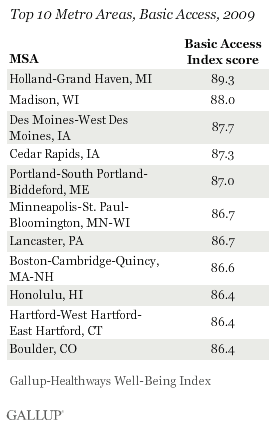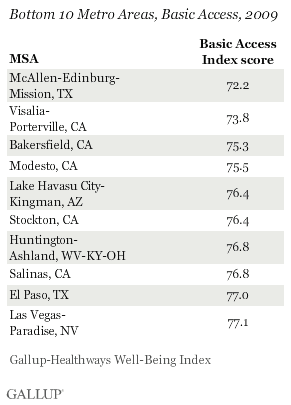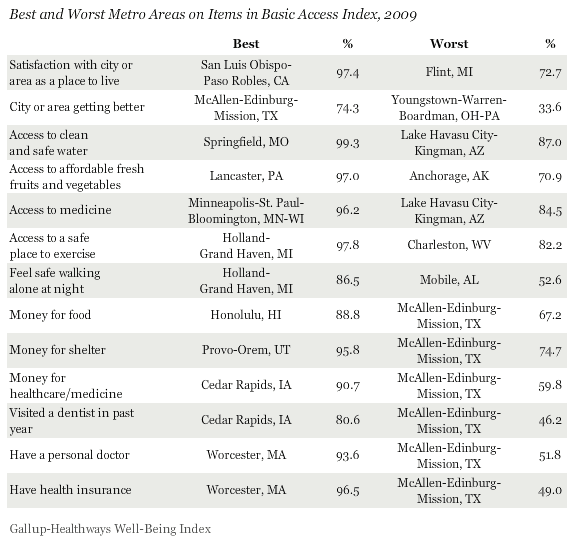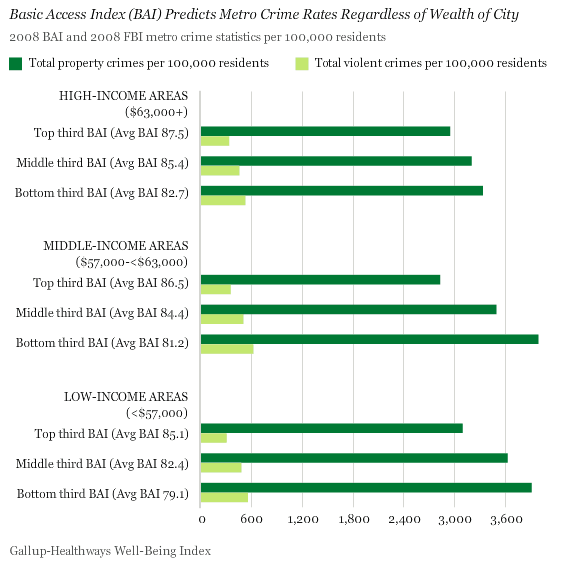WASHINGTON, D.C. -- Among the 187 U.S. metro areas ���۴�ýand Healthways surveyed in 2009, Holland-Grand Haven, Mich., led the nation in providing basic necessities -- such as safe places to exercise and easy access to fresh fruits and vegetables -- to its residents. Following closely behind Holland-Grand Haven are Madison, Wis., and two Iowa metro areas, all of which scored above 87.0 on the Gallup-Healthways Basic Access Index, a 13-item measure of Americans' access to basic necessities in the cities or areas where they live.


(See page 2 for a complete list of MSA Basic Access Index scores.)
McAllen-Edinburg-Mission, Texas, ranks last of the metro areas surveyed in 2009, with a Basic Access Index score of 72.2. Five of 10 worst metro areas for meeting residents' basic needs are in California, and these are clustered together primarily in the middle of the state. The Basic Access Index national average for 2009 was 82.2, down from 83.6 in 2008.
Not only does McAllen-Edinburg-Mission, Texas, rank at the bottom of American metro areas, in terms of residents' reports of basic needs being met, but it also does the worst on 6 of the 13 individual items within the Basic Access Index -- having enough money for food, for shelter, and for healthcare; having health insurance; having a personal doctor; and having visited a dentist in the past year.
These issues will likely continue to receive low ratings in McAllen-Edinburg-Mission throughout 2010, because the area also currently has the highest jobless rate in Texas. However, despite the current poor conditions, or perhaps because of them, this area's residents are the most optimistic in the country about their area getting better as a place to live.

Worcester, Mass., residents are the most likely to have health insurance and a personal doctor. Americans living in Cedar Rapids, Iowa, top the nation in having enough money for healthcare and having visited a dentist in the last 12 months, and Holland-Grand Haven leads in the area of safety.
In Areas Where Basic Needs Are Met, Crime Is Lower
The Gallup-Healthways data document an important link between meeting residents' basic needs and crime in their areas. Analysis of the most recent FBI crime statistics available, from 2008, and Basic Access Index data from the same year, finds that the metro areas with the best Basic Access Index scores consistently had lower violent crime and property crime rates than those with higher scores.
Underscoring the connection between better access to basic necessities and community crime rates, this pattern is preserved when controlling for average household income by sorting the metro areas into high-income ($63,000 per year or more), middle-income ($57,000 to $62,999), and low-income (less than $57,000 per year) categories.
For example, "middle income" metro areas with bottom-third basic access scores had 77% higher violent crime rates and 41% higher property crime rates than similarly wealthy top-third metro areas. Additionally, the lowest-income metro areas that maintain strong Basic Access Index scores had lower rates of violent and property crime per 100,000 residents than did the highest-income metro areas that have low basic access scores: 305 vs. 524 (violent) and 3,091 vs. 3,329 (property), respectively.

The relationship between basic access and crime documents the extent to which providing for residents' basic needs can have an impact beyond more obvious improvements in health, nutrition, and shelter. With fiscal challenges common in many communities and city governments, it may serve as good news that a focus on even the most basic needs can pay large dividends.
Results are based on telephone interviews with more than 353,000 American adults, aged 18 and older, conducted Jan. 2-Dec. 29, 2009. For annual results based on the stated total sample of national adults, one can say with 95% confidence that the maximum margin of sampling error is ±0.2 percentage points.
The Metropolitan Statistical Areas (MSAs) that are characterized in this article are defined by the U.S. Office of Management and Budget. Maximum expected error ranges for the MSAs vary according to size, ranging from <1 percentage point for the largest cities represented to ±3.1 percentage points for the smallest.
Interviews are conducted with respondents on landline telephones (for respondents with a landline telephone) and cellular phones (for respondents who are cell phone only).
In addition to sampling error, question wording and practical difficulties in conducting surveys can introduce error or bias into the findings of public opinion polls.


